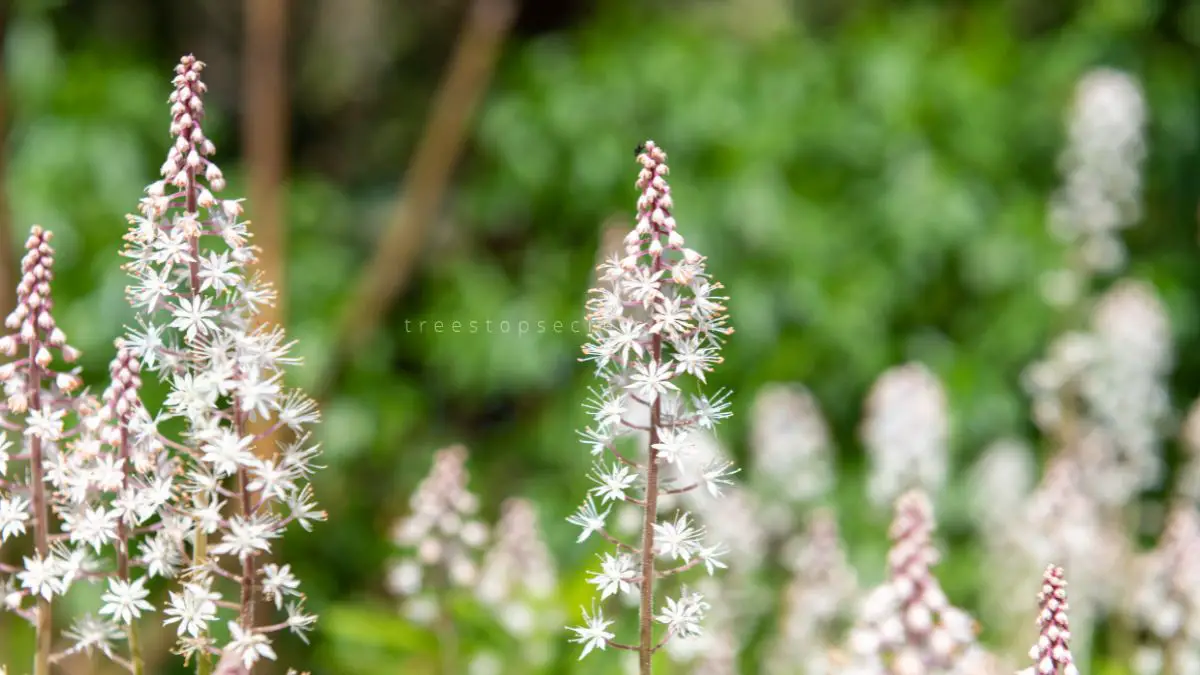
Ever wondered about planting a ground cover plant that adds charm and elegance to your garden effortlessly with flower spikes and white flowers? Look no further than the foamflower plant. With its delicate white flowers, flower spikes, and lush foliage, this perennial beauty is a must-have ground cover for any gardening enthusiast. Want to know more about this versatile perennial plant that can thrive in various conditions, shade gardens, and produce foliage from seeds? Keep reading to discover the secrets of cultivating and caring for the enchanting foamflower plant.
Key Takeaways
- Understand the needs of foamflower plants by providing well-draining soil and partial shade.
- To grow and care for foamflower successfully, maintain consistent moisture levels and avoid over-fertilizing.
- Implement advanced care techniques like dividing overcrowded plants to promote healthier growth.
- Propagate foamflower through division or stem cuttings for expanding your garden.
- Encourage blooms by deadheading faded flowers and providing adequate sunlight.
- Address common issues like powdery mildew promptly by improving air circulation around the plants.
Understanding Foamflower
Identifying Characteristics
Foamflower plants can be identified by their heart-shaped leaves with toothed edges, making them stand out in gardens. During spring, these plants produce delicate white or pink flowers, adding a touch of elegance to any landscape. One distinguishing feature is their low-growing, clumping habit, which makes them ideal ground cover options.
Types and Varieties
Exploring the world of foamflowers reveals various types and varieties. Examples include the Heartleaf foamflower and Wherry’s foamflower, each offering unique characteristics. Hybrids are also common, resulting from combining Eastern U.S. species with Western U.S. species or Asian foamflowers. Popular cultivars like 'Oakleaf', 'Brandywine', 'Running Tapestry', and 'Sugar and Spice' showcase the diversity within the foamflower family.
Growing and Caring for Foamflower
Light Requirements
Foamflower thrives in partial to full shade, benefiting from indirect sunlight. Avoid exposing it to intense sunlight.
- Place the plant where it can receive adequate but not direct sunlight.
- Prevent prolonged exposure to intense sunlight.
Soil Preferences
Foamflower prefers loamy soil enriched with humus and organic matter. Ensure the soil drains well to prevent waterlogging.
- Plant in soil amended with compost for better growth.
- Opt for well-draining soil rich in humus for optimal development.
Watering Needs
Maintain foamflower in consistently moist soil conditions by watering regularly. Avoid overwatering to prevent root rot.
- Provide the plant with consistent moisture.
- Prevent root rot by avoiding overwatering.
Temperature and Humidity
Foamflower is cold-hardy but sensitive to temperatures above zone 8. Keep it in a cool, humid environment for best results.
- Protect the plant from extreme temperature fluctuations.
- Ensure a cool and humid setting for optimal growth.
Advanced Care Techniques
Fertilization Guidelines
Foamflower typically does not need fertilizer, thriving in nutrient-rich soil. However, a complete fertilizer can be beneficial in early spring to boost growth. When fertilizing, apply sparingly to prevent nutrient imbalances that may harm the plant.
Pruning Techniques
To encourage new growth, trim back any dead or damaged foliage on your foamflower regularly. Cutting back spent flower stalks will promote continuous blooming throughout the growing season. It is advisable to prune foamflower after flowering to maintain its shape and overall health.
Moisture Tips
Ensuring evenly moist soil conditions is crucial for the optimal growth of foamflower plants. Mulching around the base of the plant can help retain moisture in the soil and regulate temperature fluctuations effectively. When watering, aim for deep but infrequent sessions to encourage deep root development.
Propagating Foamflower
Propagation Methods
Propagate foamflower by dividing dense clumps in late fall. Separate clumps into divisions and plant them apart for new growth. Utilize aboveground runners with rooting hormone for propagation success.
Seed Planting
Understand that foamflower has slow germination from seed. Sow seeds in well-prepared soil in early spring for best results. Keep the soil consistently moist until seeds germinate.
Pot Propagation
Choose a well-draining potting mix for pot propagation. Plant foamflower in containers with adequate drainage holes. Monitor soil moisture levels closely when growing foamflower in pots.
Caring for New Plants
Provide newly propagated foamflower plants with consistent care. Protect young plants from harsh sunlight and extreme weather conditions. Water new plants regularly to help establish strong root systems.
Encouraging Blooms
Understanding Bloom Months
Foamflower, a delightful plant, blooms exclusively in the spring season. Witness its beauty with delicate white or pink flowers adorning your garden. During its peak bloom months, expect a lush display of flower spikes.
Bloom Encouragement Techniques
To foster continuous blooming, make sure to deadhead spent flowers regularly. Ensure the plant receives ample sunlight and water for robust flowering. Boost healthy flower production by applying a balanced fertilizer as needed.
- Deadhead spent flowers
- Provide adequate sunlight and water
- Apply balanced fertilizer
Deadheading Practices
Prevent seed formation by promptly removing faded flowers from the foamflower plant. For effective deadheading, cut back flower stalks to the base. Engage in regular deadheading practices to extend the blooming period of this charming plant.
- Remove faded flowers promptly
- Cut back flower stalks to the base
- Regular deadheading prolongs blooming period
Dealing with Common Issues
Pests and Problems
Slugs and snails are common pests that feed on foamflower leaves, posing a threat to the plant's health. To prevent fungal diseases, avoid overhead watering which can create a damp environment ideal for fungi to thrive. Promptly address any pest infestations to safeguard the foamflower plant.
- Watch out for: slugs and snails
- Prevent: fungal diseases
- Address promptly: pest infestations
Bloom Production Issues
Factors like insufficient sunlight can hinder bloom production in foamflowers. Nutrient deficiencies may also impact flower development, affecting the plant's ability to produce blooms. It's essential to address any environmental stressors that could potentially impede blooming.
- Troubleshoot: insufficient sunlight
- Check for: nutrient deficiencies
- Address: environmental stressors
Summary
You've now mastered the art of growing and caring for foamflower plants. Understanding their needs, implementing advanced care techniques, propagating them successfully, encouraging blooms, and handling common issues are all part of your gardening arsenal. By following these steps diligently, you ensure vibrant and healthy foamflowers in your garden. Remember to stay vigilant and proactive in caring for your plants to enjoy a flourishing display of foamflowers. Share your newfound knowledge with fellow gardeners and continue to expand your green thumb expertise.
Frequently Asked Questions
How do I grow foamflower plants successfully?
To grow foamflower plants successfully, plant them in well-draining soil with partial to full shade. Keep the soil consistently moist but not waterlogged. Mulch around the plants to retain moisture and control weeds. Regularly fertilize during the growing season for optimal growth.
Can foamflowers be propagated easily?
Foamflowers can be propagated easily through division or stem cuttings. Divide mature plants in spring or fall, ensuring each division has roots attached. For stem cuttings, take 3-4 inch cuttings from healthy stems, remove lower leaves, dip in rooting hormone, and plant in a moist growing medium.
What are some advanced care techniques for foamflowers?
Advanced care techniques for foamflowers include deadheading spent blooms to encourage more flowering, applying a balanced fertilizer in early spring, and dividing overcrowded clumps every few years to maintain plant health and vigor.
How can I encourage blooms on my foamflower plant?
To encourage blooms on your foamflower plant, provide consistent moisture without waterlogging the soil, ensure they receive adequate light conditions based on the variety (partial shade to full shade), deadhead spent flowers regularly, and fertilize with a balanced fertilizer during the growing season.
What are common issues faced when growing foamflowers?
Common issues when growing foamflowers include powdery mildew, leaf spot diseases, root rot due to overwatering, and poor flowering caused by inadequate light or nutrient deficiencies. Proper cultural practices such as good air circulation and avoiding overhead watering can help prevent these problems.
Image Source: Paid image from CANVA





